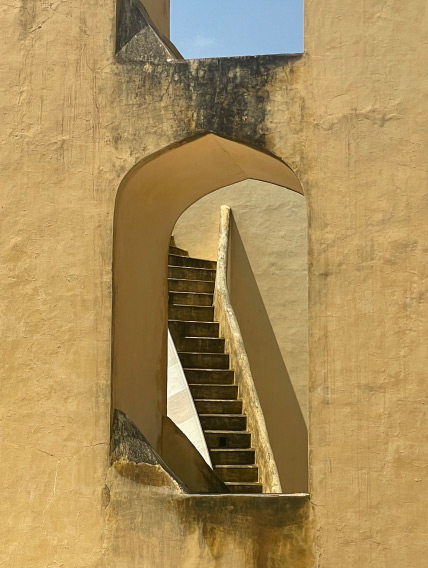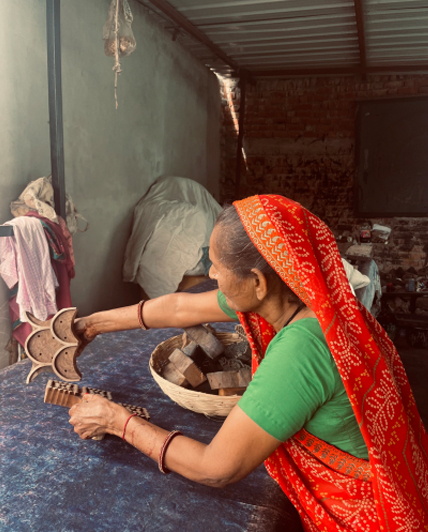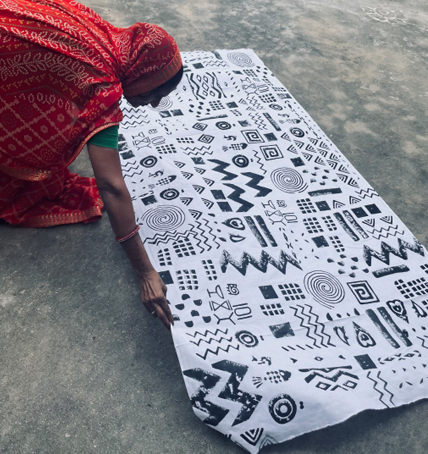



This indigenous craft is said to have originated in China around 4,500 years ago and brought to India under the Mughal regime with Jaipur as its heart of operation. It was only after it was brought to India that hand block printing reached its highest visual expression.

Jantar Mantar, Jaipur Image by Vishwa Patel
Jaipur is known to be a textile hub with block printing being one of the most celebrated art forms. It is still practiced by the Chhipa community. The word Chhipa means “to dye” or “to stamp” and as the connotation indicates, the community primarily consists of people who dye and print cloth. Some of the members are also present in Gujarat, and even parts of Pakistan.

Carving of blocks in Bagru Village
Image by Vishwa Patel
The process of block printing involves hand-carving of wooden blocks preferably using rosewood owing to its durability. They are chiselled into intricate patterns and designs and are then dipped in dye and stamped onto long lengths of cotton fabric.
Indians possessed unparalleled expertise in the secrets of natural plant dyes, particularly with mordants (metallic salts that both create color and allow it to adhere to fabric). A kind of mud resist-printing, called dabu, which allows areas of a design to be reserved from dye, also flourished here. A series of combinations of mordant and resist stamping and dyeing enabled Indian printers to create uniquely complex designs, coveted from Southeast Asia and palaces of Mughal emperors to the far-flung capitals of Western Europe. Between outside influences and the diversity of the subcontinent’s own indigenous communities and tribes, India has yielded one of the most magnificent pattern vocabularies ever. And yet for the past 200 years the industry has been on the precipice of extinction, doomed in part by the popularity that helped create it.
We at Gingerblu, aim to let the craft thrive again. Block printers today have moved towards faster and easier ways of production to survive the demand while maximising their profits. But in the process, losing the authenticity of the practice. So, when I began my month long adventure in and around Jaipur of finding true artisans to work with for Gingerblu, I stayed away from the popular block printing communities in Sanganer and Bagru to find workshops which are slow in production and caters to the demand that they can easily accommodate while respecting the art of block printing in its essence.
I met with several people of the Chippa community in Sanganer to understand their practices and what led them to divert from the traditional practices of block printing. On my way back from of one these meetings, I came across a small shop carrying a range of block prints from Kaladhera, a small village 42 kms from the city of Jaipur. The designs were unique and one of a kind and I knew from the creativity and intricacy of the prints that I had found what I was looking for. I headed to their workshop in Kaladhera the next morning to see for myself and it was everything I had wished for it to be


Left : Babulalji’s wife ; Right : Vishwa experimenting with the printing techniques in Kaladhera Image by Vishwa Patel
A small workshop set up on the terrace of their humble abode situated right next to a neem tree in the centre of the village. The village lanes were narrow and quaint, the houses beautifully coloured in greens, pink and blues. The entire village seemed to take notice of this new lady in a kurta and denim, aka me entering the house of Babulalji. Babulalji, his wife and I spent the morning getting to know each other and our work while going through his endless collection of beautifully carved teak blocks. His workshop had four tables to print with two of them unoccupied at the moment making it a perfect opportunity for me to explore creating new prints on my own using the blocks at my disposal.

Drying the printed fabric Image by Vishwa Patel
Babulalji’s wife kept me entertained with her questions regarding the life in a big city like Bombay and getting me acquainted with the customs of theirs in Rajasthan. She insisted to cook lunch for me while I was working with them and every single day I was presented with a unique specialty in Rajasthani cuisine, home cooked with love and taste. I woke up eagerly every morning to reach Kaladhera at 9 am for the next five days, working closely with Babulalji to create block prints desirable to the consumers of today. Together, we took a leap of faith and designed thirty new prints over the period of five days.
